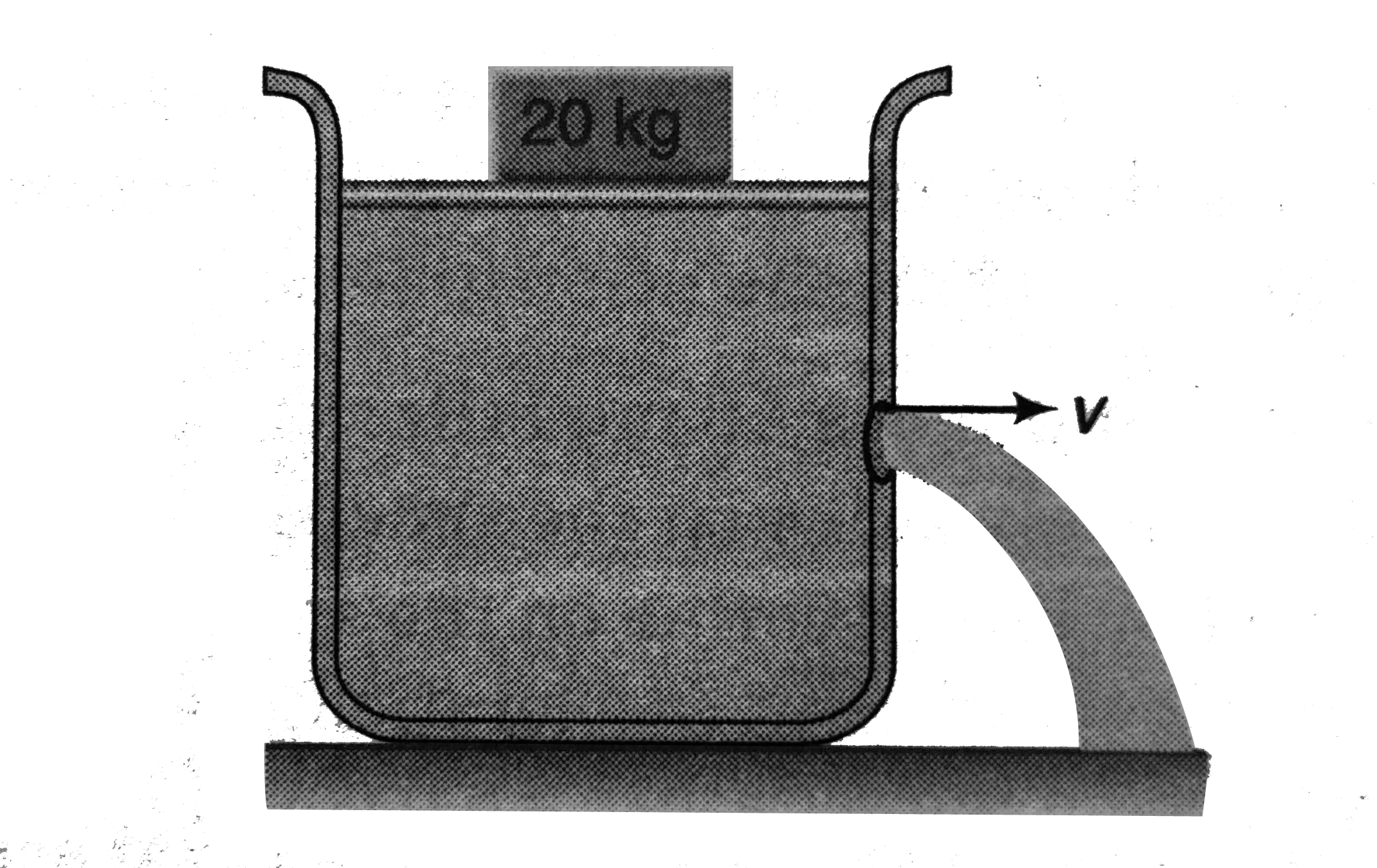A area of cross section of a large tank is . It has an opening near the bottom having area of cross section . A load of 20 kg is applied on the water at the top. Find the velocity of the water coming out of the opening at the time when the height of water level is 50 cm above the bottom. Take
The correct Answer is:B, C
To solve the problem step by step, we will follow the principles of fluid mechanics, particularly Bernoulli's equation.
Step 1: Understand the Problem
We have a large tank with an area of cross-section At=0.5m2 and an opening at the bottom with an area of cross-section Ao=1cm2=0.0001m2. A load of 20kg is placed on the water, and we need to find the velocity of water exiting the opening when the height of the water is h=50cm=0.5m.
Step 2: Calculate the Pressure at the Opening
The pressure at the water surface (point A) consists of the atmospheric pressure and the pressure due to the load. The pressure due to the load can be calculated using the formula:
P=P0+mgAt
Where:
- P0 is the atmospheric pressure (which we will assume cancels out later).
- m=20kg
- g=10m/s2
- At=0.5m2
Calculating the pressure due to the load:
P=P0+20×100.5=P0+400N/m2
Step 3: Apply Bernoulli's Equation
Using Bernoulli's equation between point A (water surface) and point B (opening):
PA+ρgh+12ρv2A=PB+ρghB+12ρv2B
At point A, the velocity vA is negligible due to the large area compared to point B. Thus, we can simplify the equation:
PA+ρgh=PB+12ρv2B
Step 4: Substitute Known Values
Assuming PB is atmospheric pressure P0, we can write:
P0+400+ρgh=P0+12ρv2B
Canceling P0 from both sides:
400+ρgh=12ρv2B
Where ρ (density of water) is approximately 1000kg/m3 and h=0.5m:
400+1000×10×0.5=12×1000×v2B
Calculating the left side:
400+5000=12×1000×v2B
5400=500×v2B
Step 5: Solve for vB
Rearranging gives:
v2B=5400500=10.8
Taking the square root:
vB=√10.8≈3.29m/s
Final Answer
The velocity of the water coming out of the opening is approximately 3.29m/s.
---
We have a large tank with an area of cross-section At=0.5m2 and an opening at the bottom with an area of cross-section Ao=1cm2=0.0001m2. A load of 20kg is placed on the water, and we need to find the velocity of water exiting the opening when the height of the water is h=50cm=0.5m.
The pressure at the water surface (point A) consists of the atmospheric pressure and the pressure due to the load. The pressure due to the load can be calculated using the formula:
- P0 is the atmospheric pressure (which we will assume cancels out later).
- m=20kg
- g=10m/s2
- At=0.5m2
Using Bernoulli's equation between point A (water surface) and point B (opening):
Assuming PB is atmospheric pressure P0, we can write:
Rearranging gives:
The velocity of the water coming out of the opening is approximately 3.29m/s.
Topper's Solved these Questions
- FLUID MECHANICSBOOK - DC PANDEY ENGLISHCHAPTER - FLUID MECHANICSEXERCISE - Subjective Question
2 Videos
- FLUID MECHANICSBOOK - DC PANDEY ENGLISHCHAPTER - FLUID MECHANICSEXERCISE - Level 2 Single Correct
36 Videos
- FLUID MECHANICSBOOK - DC PANDEY ENGLISHCHAPTER - FLUID MECHANICSEXERCISE - Level 1 Single Correct
49 Videos
- EXPERIMENTSBOOK - DC PANDEY ENGLISHCHAPTER - EXPERIMENTSEXERCISE - Subjective
15 Videos
- GENERAL PHYSICSBOOK - DC PANDEY ENGLISHCHAPTER - GENERAL PHYSICSEXERCISE - INTEGER_TYPE
2 Videos
Similar Questions
A long cylindrical tank of cross-sectional area 0.5m2 is filled with water. It has a small hole at a height 50cm from the bottom. A movable piston of cross-sectional area almost equal to 0.5m2 is fitted on the top of the tank such that it can slide in the tank freely. A load of 20kg is applied on the top of the water by piston, as shown in the figure. Calculate the speed of the water jet with which it hits the surface when piston is 1m above the bottom. (Ignore the mass of the piston)

View SolutionAn open vessel contains water upto height 50 cm in it. What is the velocity of efflux through an orifice at height 30 cm above the bottom level ? [Take g = 10 m/s2]
View Solution
Knowledge Check
A cylinder of height 20 m is completely filled with water. The velocity of efflux of water through a hole on the side wall of the cylinder near its bottom is (Take g=10ms−2)
A10ms−1B20ms−1C25.5 m s−1D5ms−1
The cross-section of a canal is a trapezium in shape. If the canal is 10m wide at the top 6m wide at the bottom and the area of cross-section is 72m2 determine its depth.
View SolutionThe area of cross section of the two arms of a hydraulilc press are 1 cm^2 and 10 cm^2 respectively figure. A force of 5N is applied on the water in the thinner arm. What force should be applied on the water in the thicker arm so that the water may remain in equilibrium?
 ,
,
View SolutionThe area of cross section of the two arms of a hydraulilc press are 1 cm^2 and 10 cm^2 respectively figure. A force of 5N is applied on the water in the thinner arm. What force should be applied on the water in the thicker arm so that the water may remain in equilibrium?
 ,
,
View SolutionA fixed container of height H with large cross-sectional area A is completely filled with water. Two small orifice of cross-sectional area a are made, one at the bottom and the other on the vertical side of the container at a distance H/2 from the top of the container find the time taken by the water level to reach a height of H/2 from the bottom of the container.
View SolutionA lawn sprinkler has 20 holes, each of cross-sectional area 2.0x10−2cm2, and is connected to a hose pipe of cross sectional area 2.4cm2. If the speed of water in the hose pipe is 1.5ms−1, the speed of water as it emerges from the holes is
View SolutionA cylindrical vessel open at the top is 20cm high and 10cm in diameter. A circular hole of cross-sectional area 1cm2 is cut at the centre of the bottom of the vessel. Water flows from a tube above it into the vessel at the rate of 102cm3/s. The height of water in the vessel under steady state is (Take g=10m/s2).
View SolutionA hemi-spherical tank of radius 2 m is initially full of water and has an outlet of 12cm2 cross-sectional area at the bottom. The outlet is opened at some instant. The flow through the outlet is according to the law v(t)=0.6√2gh(t), where v(t) and h(t) are, respectively, the velocity of the flow through the outlet and the height of water level above the outlet and the height of water level above the outlet at time t, and g is the acceleration due to gravity. Find the time it takes to empty the tank.
View Solution
